Digital Art Weeks
Committee & Contact
Partners
Overview
Symposium
Festival
Exhibition
Digital Parcours
Workshops
Participants
Disclaimer
Last update: December 30, 2012, at 12:36 PM
WEDNESDAY JULY 12, 2006
|
The Digital Parcours consists of series of performances, installations and artworks, that have been either realized with a computer or will be performed with the aid of one or more computers. In addition to experiencing the variety of works and the versatility of today’s computers, visitors will have the chance to meet many of the artists and scientists behind the works and also to visit those institutes which are partners in this years Digital Art Weeks. You are welcome to join the organizers of the Digital Art Weeks in a specially planned guided tour that will begin with coffee at 13:00 at ETH Zurich, RZ Building, Floor H, Clausiusstrasse 59, 8092 Zurich. The tour will then commence and continue through to all stations of the Parcours listed in the order below. Travel is by foot and tram. Some visitors may like to bring their bikes. The duration of the event is circa two hours. Persons interested in participating in the Symposium may also register at this time. The Works by L. Paul, E. Maesaki & W. Pappenheimer will be on view for the duration of the DAW06 from July 12th to the 15th at the below given hours. The guided parcours tour finishes off with a second closing apero at 17:00 in the VisDome.
PARCOURS PROGRAMLocation: ETH Zurich, RZ Building, H Floor
Location: ETH Zurich, ETF C106
Location: Platzspitz (Behind Landesmuseum)
Location: School of Art and Design Zurich
Location: Escher-Wyss-Platz
Location: Cabaret Voltaire
Location: ETH VisDome
|
 |
PERFORMANCES & INSTALLATIONS
|
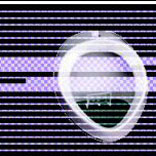 |
GBA CORE DUMP V2.0Leonard J. Paul (CAN) This installation consists of a GBA with a flash ROM running custom-made software, which explores issues of public and private space. The GBA will be mounted in the bathroom within a small security picture frame to encourage viewing and listening, but discourage un-hygienic interaction. The software creates recombinant images and sounds from the real world samples and the work's title shows that the GBA's CPU will be "dumping" out recombinant and pseudo-random generative images and audio from its internal memory. Instead of dumping out memory to a printer, it displays it visually and through sound. The notions of intimate space and the fetishization and anthropomorphizing of handheld game units is explored in a real-time audiovisual experience shared by both the GBA and the bathroom occupant. Version 1 of this installation was shown in the women's washroom at the Open Space Gallery for Interactive Futures 2006 in Victoria, Version 2 of the installation will include new music, audio samples and images specifically suited to the new site of Computer Systems Institute ETH Zurich and further challenge conventional notions of hand-held gaming systems. |
|
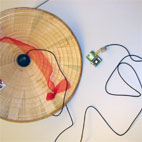 |
CHINA GATESArt Clay (USA/CH), Dennis Majoe (ENG) & The China Gates Workshop-Ensemble (INT) The early experiments of Charles Ives's father with marching bands crossing at intersections and his son's adoption of it, proves that interest in exploring mobility has fascinated even before electronic devices. As with Ive's marching band polytonality, we also have the opportunity using modern technologies from the Walkman to the Wearable not only interact with local surroundings like Ives, but for the first time also on a world wide level. Global networking systems such as GPS amoungst others have created a ubiquitous environments in which we can now make art in. China Gates is a work for GPS Wrist conductors and tuned gongs for an ensemble. The work addresses the concept of audience in public space through the possibilities of the GPS Wrist Conductor and an acoustic concept of music making in public space. Anyone interested in joining the workshop is welcome. It is open free of charge to those interested. The performance will be held regardless of whether conditions at Platzspitz and will be performed by a group of artists and musicians who took part in the DAW06 Mobile Music Workshop. |
|
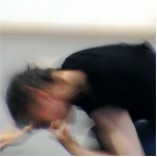 |
ROSEBUDPablo Ventura (ESP/CHE) Rosebud is the result of a 4 minutes pilot film created to investigate the possibilities of 3D technology in Video Dance. The title makes reference to a famous film sequence in Orson Welles’ film "Citizen Kane": A crystal ball drops out of the protagonists hand and as it rolls into a close up shot, it establishes a rather bizarre perspective. At this moment the protagonist speaks out "Rosebud". In the 3-D Rosebud film, a dancer starts out from an orange transparent ball and dances a sequence which traces a diagonal in space, allegorically making the same journey as the mentioned crystal ball in "Citizen Kane's" sequence. 3D imaging accentuates dramatically the relationship between the dancer and the space she inhabits, achieving a fascinating hyperrealist synergy of dance and space. Space in the context of 3-D dance film is not perceived simply as a flat background or backdrop in which a dance takes place, but via the filming technique, space itself is as important as the dancers movements. The film was created at the Computer Sytems Institute ETH Zurich with students of that Institute. Special thanks are due to Dr. Cary Kornfeld and his class for the technical realization and to Prof. Luc van Gool and his Computer Vision Laboratory who kindly helped us to play the film on their stereo system. |
|
 |
WATER BELL PROJECTEtsuko Maesaki (JPN) The Waterbell Project is a sound installation based on the Japanese 'Suikinkutsu'. Suikinkutsu ("Water Harp") is a unique feature of Japanese gardens. It consists of a large earthen jar with a hole in the bottom. This jar is buried upside down into the ground next to a water basin. When the waterdrops seep from above into the jar, they make a sound somewhat similar to what you would hear in an underground cave. The Waterbell Project consists of five vessels standing in a basin. A tube directs drops of water to the top of each of these vessels. When they drip into the water inside the vessels a sound can be heard. The frequency of the drops and the amount of water in the basin is controlled by a computer. At the same time this computer gathers realtime data from the internet: The price of oil in Japan and the temperature of the ocean. The frequency of the waterdrops dripping into the vessels corresponds with the temperature of the ocean, the water in the basin raises and drops with the price of oil, hence changing the quality of the sound made by the drops. |
|
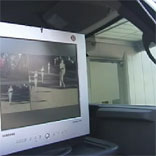 |
SVENAmy Alexander (USA) SVEN (Surveillance Video Entertainment Network) is a system that can be set up in public places - especially in situations where a CCTV display might be expected. The system can be configured for either a mobile unit or stationary location, and consists of cameras, video display, speakers and software. The software consists of a custom computer vision application that tracks pedestrians and detects their characteristics, and a real-time video processing application that receives this information and uses it to generate music-video like visuals from the live camera feed. The resulting video and audio are displayed on a monitor in the public space, interrupting the standard security camera type display each time a potential rock star is detected. The idea is to humorously examine and demystify concerns about surveillance and computer systems not in terms of being watched, but in terms of how the watching is being done - and how else it might be done if other people were at the wheel... |
|
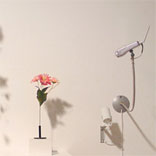 |
MOTION STILL LIFE 1Will Pappenheimer (USA) Motion Still Life 1 extends the artistic tradition of the picturesque and spatial object arrangement into the domain of the Internet. A live Web camera frames a physical still life scene with vase, flowers and still life objects. Through its counterpart website, aesthetic controls allow internet viewers from anywhere to adjust the composition telematically in the distant space of the gallery. The Internet user is the surrogate artist. The time and space of the scene is ever-changing and accessible for the moment that becomes the still life. Exhibition visitors are able to see virtual participants configuring the still life through object movement, blinking LEDs connected with online activity, and multi-colored lighting for night time or alternative illumination. The mechanism is constructed from a self-contained network pan and tilt surveillance camera which has been disassembled and reconfigured for a more friendly gesture. http://www.motionstilllife01.thruhere.net/ |
|
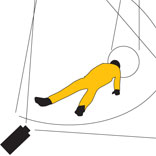 |
ALMOST LOSTHeinrich Lüber & Corebounce (CH) "In der Performance spreche ich über zwei Stunden endlose Wortketten und projiziere diese gewissermassen von Innen an eine meinen Kopf umgebende Sphère. Die sich selbst dekonstruierende Sprache wird durch eine interaktive Technologie umgeformt und in Lichtform auf die Sphère und den Umgebungsraum zurückgeworfen. Die Projektionen zeigt eine Virtualität im Sinne einer "plastischen" Verformung in Möglichkeitsräume hinein. Das die Figur umgebende Halbrund bildet eine Andeutung einer zweiten Schicht dieses dynamischen Raumsystems, die begehbar ist und worin der Zuschauer sich als formender/aktiver Mitspieler in diesem System erleben kann." (Heinrich Lüber) → www.heinrichlueber.ch | → www.corebounce.org |